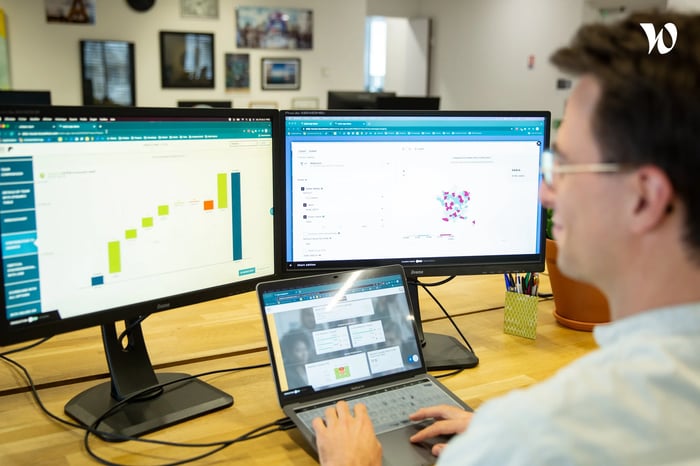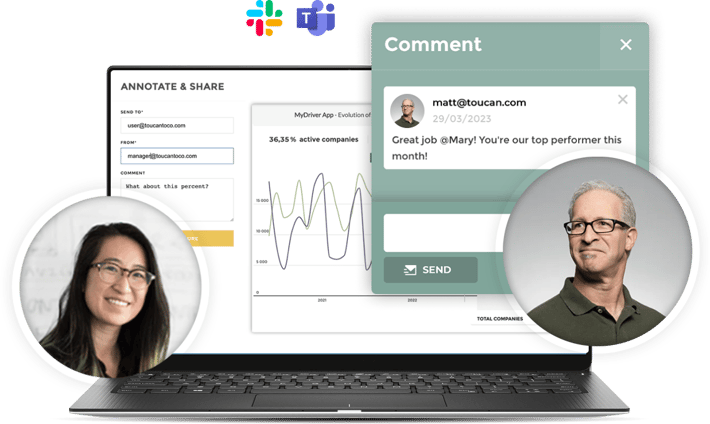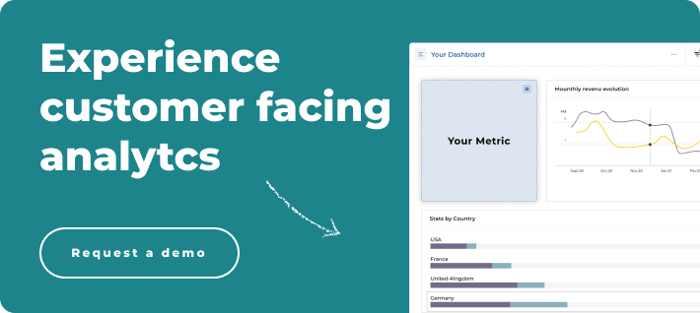Customer-facing analytics vs customer analytics, what's the difference?
Customer analytics is helpful in analyzing key customer data to make informed decisions, especially about client strategy and performance. In spite of the fact that customer analytics is undoubtedly useful, especially for businesses, their application is limited to this use case.
Customer-facing analytics was created to help in another area: bring value to your customers with data.
Customer-facing analytics helps companies interact with their customers in real time, which requires a completely different approach compared to customer analytics. Let's take a closer look at customer-facing analytics and how it's designed to engage end-users with data.

What is Customer Analytics?
Customer analytics, or customer data analysis, is the process of gathering and analyzing customer data in order to gain insight into customer behavior. Customer analytics requires various tools for collecting and organizing different types of data and a methodological framework for analyzing and understanding this data. Analytics is used by businesses to make decisions related to marketing, product development, sales, and other areas of business.
You might be able to make simple business decisions with the help of customer analytics, such as determining which advertising platform is giving you the best return on investment. Or make complex business decisions like figuring out your entire customer journey and building personalized marketing campaigns to match that.
How Customer-Facing Analytics Differs From Customer Analytics
There are several differences between customer-facing analytics and customer analytics. Perhaps the most important difference is that customer-facing analytics is focused on offering your customers ready-to-use analytics, or visualization, while customer analytics is focused on internal analysis to make business decisions.
|
Customer-Facing Analytics |
Customer Analytics |
|
Deals with product and usage data |
Deals with only customer data |
|
Needs faster loading times |
Loading time is a relative non-issue |
|
Security for a multi-tenant environment |
Single-tenant security environment |
|
Integrated into existing user applications |
Requires toggling between several apps to synthesize and analyze data |
4 pillars of a customer-facing analytics solution
1. Customer-Facing Analytics Scope
Customer-facing analytics often requires only product data. Internal-facing analytics like Customer analytics often draws from many more sources, looking at a company holistically, while most customer-facing data exposes product data to users. For that reason, the data scope is typically much more focused for customer-facing analytics.

2. Customer-Facing Analytics Speed
Despite its ability to provide a complete range of company data, customer analytics can be a bit time-consuming to load. Customer-facing personnel (such as sales teams) require real-time access to data during interactions with their customers. With an embedded analytics solution, they are able to access contextually relevant information instantly through dashboards.
Customer analytics also has other speed disadvantages built into its user interface, requiring the user to switch between several applications in order to synthesize and analyze data. Customer-facing analytics aggregates a narrower set of data and delivers it in a more easily-consumable way.
3. Customer-Facing Analytics Security and Governance
Due to the complexity of multi-tenant environments and their integration into existing user applications, security is also more important with customer-facing analytics than with customer analytics.
Internal security is less complex, so it carries fewer stakes than customer-facing analytics. The security risks associated with internal teams are simply lower because they are a known quantity.
You don't have to sacrifice data security & governance protocols to share data with customers. You can establish separate security rules for embedded analytics that are stricter than customer analytics with the right embedded analytics solution.
Detailed data cleaning and storage procedures, data modeling considerations, and data access credentials should be outlined in your data governance policy. You should continue to evolve your security rules as your product evolves.
4. Main Competitive Advantage of Customer-Facing Analytics
Both you and your customers can benefit from a customer-facing analytics solution by providing them with:
- A seamless, user-friendly app experience with built-in real-time data access for your customers
- Better security that reduces dependencies on your internal teams to build one-off security solutions
- Improved customer service supported by strong user data; the longer people spend using the app, the more data it gathers, which over time becomes a valuable asset that can enhance the user experience
- An interface explicitly designed for working with data that is being shared and accessed by end-users
Customer-Facing Analytics Grants Autonomy to Customers
Customer-facing analytics frees up your IT staff because it is built to be used by non-technical business users. As embedded analytics provide users with easier and more seamless access to data, customers can find solutions to their issues immediately without assistance.
A white-label dashboard solution can be easily customized to the customer's environment, where tools can be incorporated to capitalize on customer-facing analytics to their full potential. Through familiarity and simplicity, customer-facing analytics dashboards assist UX & UI by providing insights to help you leverage your product.
0-code, customizable dashboards increase the relevance and usability of data by serving crucial info without the need for a data scientist. Customer autonomy unloads your engineering team's bandwidth, both in terms of development and support, so they can concentrate on other things, like product development.


